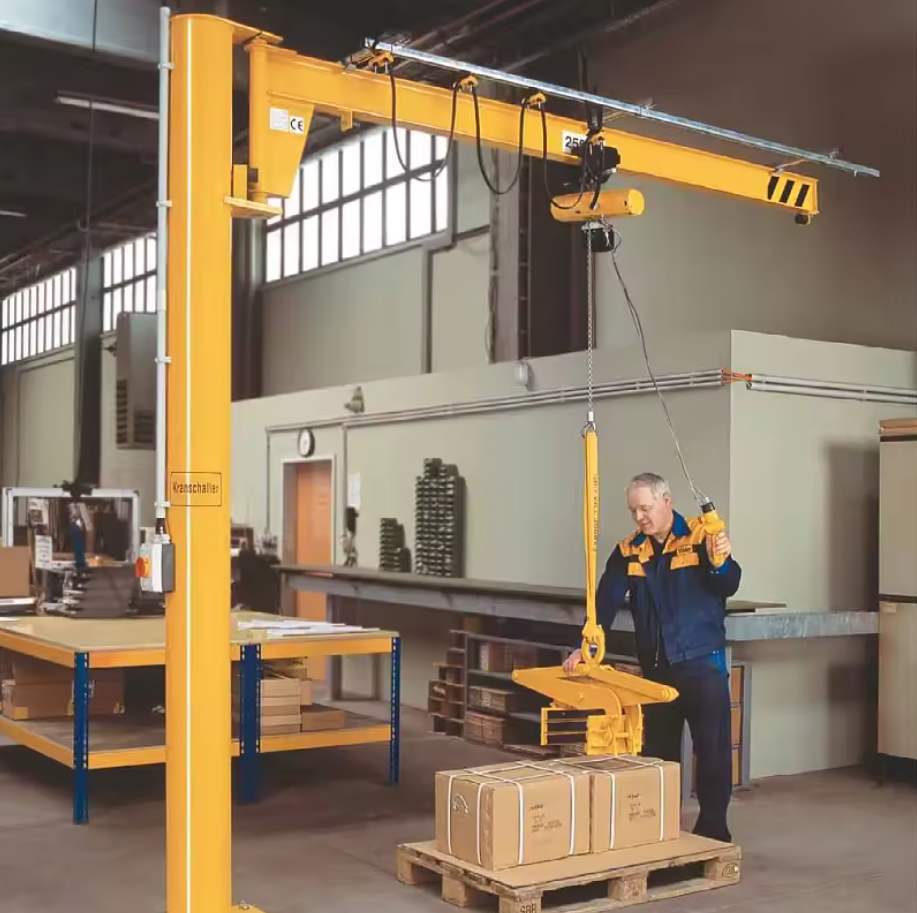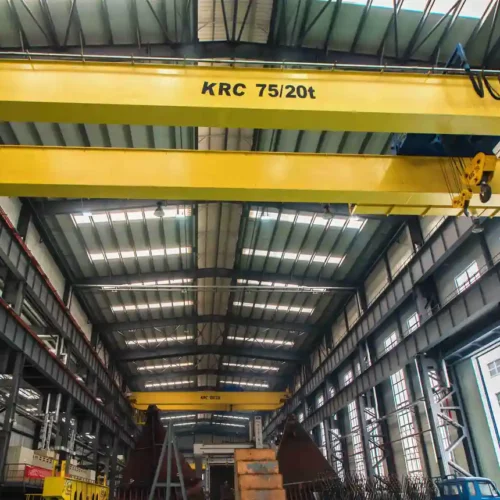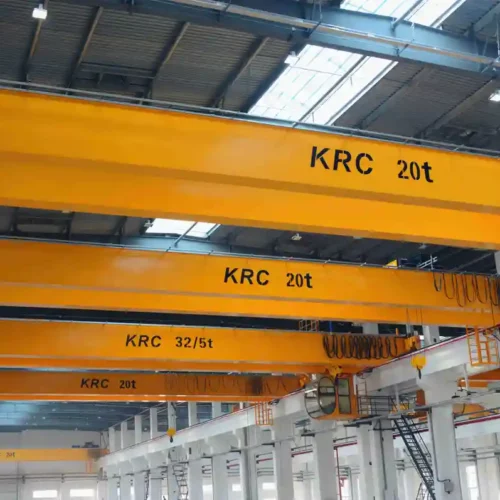warehouse gantry crane Safety Certifications
Warehouse gantry cranes are critical for material handling, but their operation involves significant safety risks. Ensuring safety involves obtaining necessary certifications and adhering to standards set by relevant authorities.
1. OSHA (Occupational Safety and Health Administration): OSHA provides regulations for operating cranes safely. Employers should ensure compliance with standards such as OSHA 1910.179, which pertains to overhead and gantry cranes, covering aspects from design and inspection to operation and maintenance.
2. ANSI (American National Standards Institute): ANSI/ASME B30.2 is a key standard for overhead and gantry cranes. It outlines design specifications, inspection procedures, and safe operation practices. Compliance helps in minimizing mechanical failures and accidents.
3. NCCCO (National Commission for the Certification of Crane Operators): While more common for mobile cranes, NCCCO certification ensures that operators possess the necessary skills and knowledge. Certification indicates that operators can safely manage crane operations, crucial even for less complex setups like gantry cranes.
4. ISO (International Organization for Standardization): ISO 9927-1 addresses general requirements for the inspection, maintenance, and operation of cranes. Following international standards helps in assuring global compliance and promoting consistent safety practices.
5. LOLER (Lifting Operations and Lifting Equipment Regulations): Although specific to the UK, LOLER sets out requirements for the safe installation, operation, and inspection of lifting equipment. Adherence ensures that lifts are conducted safely and reduces the risk of accidents.
6. Regular Training and Inspection: Regular safety training and detailed inspections (daily, monthly, and annual checks) are crucial for safety. Documentation should be maintained meticulously for compliance and record-keeping.
By adhering to these certifications and standards, warehouse operations can significantly mitigate risks, ensuring a safer working environment for personnel involved in crane operations.
List Reference Technical Parameters of “warehouse gantry crane”
A warehouse gantry crane is an essential piece of material handling equipment widely used in storage facilities and production plants. Understanding its technical parameters is crucial for selecting the right model for specific operational needs. Here are key technical parameters to consider:
1. Lifting Capacity: This denotes the maximum weight the crane can safely lift, commonly ranging from a few tons to over 100 tons.
2. Span Width: The horizontal distance between the supports (legs) of the gantry crane. It typically varies from a few meters up to 30 meters or more.
3. Lifting Height: The vertical distance the hook or lifting mechanism can travel, often ranging from 3 meters to 30 meters.
4. Travel Speed: Includes both the hoisting speed (vertical movement) and the trolley speed (horizontal movement along the girder). Speeds can vary based on the specific model and can be critical for operational efficiency.
5. Crane Speed: The speed at which the entire crane can move along its tracks or wheels, affecting how quickly it can position loads.
6. Duty Class: Provides an estimation of how frequently the crane will be used and the average weight of the loads. Classifications typically follow standards such as FEM or CMAA, with classes ranging from light (A1) to very heavy duty (A8).
7. Power Supply: Voltage and phase requirements for running the crane. Common power supplies include 380V/50Hz/3-Phase or 460V/60Hz/3-Phase.
8. Control System: Whether the crane uses a manual, pendant, wireless remote, or cabin control system, which influences ease of operation and safety.
9. Material and Construction: The type of steel or alloy used in the construction of the crane’s main frame and gantry, which impacts the durability and robustness.
10. Safety Features: Including limit switches, overload protection, emergency stop functions, and anti-collision systems.
By evaluating these technical parameters, businesses can choose the most appropriate warehouse gantry crane that fits their operational demands and ensures safety and efficiency.
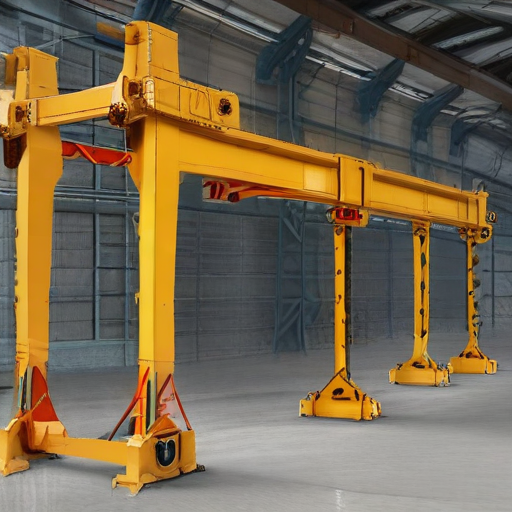
List Product features of “warehouse gantry crane”
A warehouse gantry crane is a vital piece of equipment designed to enhance productivity and safety in material handling operations. Here are some of its key product features:
1. Heavy Load Capacity: Able to lift and transport substantial weights, often ranging from several tons up to hundreds of tons, making it suitable for various industrial applications.
2. Adjustable Span and Height: Features customizable dimensions to fit different warehouse sizes and operational needs, ensuring versatility and adaptability.
3. Durable Construction: Built from high-strength steel or aluminum alloys, providing robust structural integrity and longevity, even in demanding environments.
4. Mobility Options: Available in fixed and mobile configurations, with the latter featuring wheels or tracks for ease of repositioning within the workspace.
5. Precision Control: Equipped with advanced control systems, including pendant controls, wireless remote controls, or automated options, enabling accurate and safe load handling.
6. Safety Features: Includes emergency stop buttons, overload protection systems, anti-collision devices, and limit switches to enhance operator safety and prevent accidents.
7. Ease of Assembly and Maintenance: Modular design facilitates straightforward installation, disassembly, and maintenance, reducing downtime and operational costs.
8. Wide Range of Applications: Suitable for diverse environments such as manufacturing plants, warehouses, shipyards, and construction sites, reflecting its versatile utility.
9. Smooth Operation: Incorporates high-quality bearings, motors, and other components ensuring reliable and quiet operation, minimizing workplace disruptions.
10. Customizable Options: Can be tailored with various accessories like hoists, trolleys, and spreader bars to meet specific operational requirements.
11. Environmental Resistance: Treated with protective coatings to resist corrosion, suitable for both indoor and outdoor use.
12. Training and Support: Often comes with technical support and training programs to ensure proper use and maintenance.
These features make warehouse gantry cranes indispensable for efficient and safe material handling in numerous industrial settings.
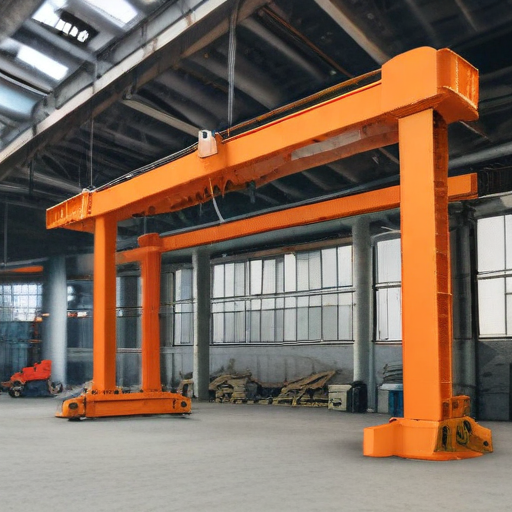
List Application of “warehouse gantry crane”
A warehouse gantry crane is a versatile piece of equipment highly valued for its ability to handle heavy loads and improve operational efficiency across various sectors. Below are some notable applications of a warehouse gantry crane:
1. Material Handling: Essential for moving bulky and heavy items within the warehouse, reducing manual labor, and increasing productivity.
2. Loading and Unloading: Facilitates the loading and unloading of goods and materials from trucks or other transportation vehicles, streamlining the logistics process.
3. Storage Management: Assists in the positioning and stacking of items in storage racks or designated areas, optimizing space utilization and inventory management.
4. Assembly Processes: Supports assembly operations by transporting heavy components to different assembly stations within the warehouse.
5. Cross-Docking: Speeds up the cross-docking process by efficiently transferring goods from the incoming delivery dock to the outgoing shipping dock without storing them in between.
6. Maintenance and Repairs: Useful for lifting heavy machinery or equipment during maintenance and repairs, providing essential support for regular upkeep activities.
7. Order Fulfillment: Enhances order fulfillment efficiency by enabling quick and accurate picking, packing, and shipping of large or heavy products.
8. Scrap Handling: Effective in handling and transporting industrial scrap and recyclable materials within a facility, promoting better waste management practices.
9. Manufacturing Support: Integral in manufacturing environments for moving raw materials and finished products between different production lines and storage areas.
10. Specialized Applications: Customizable for industry-specific tasks such as handling large rolls in paper industries or heavy molds in plastic manufacturing units.
By integrating a warehouse gantry crane, businesses can significantly enhance operational efficiency, safety, and workflow continuity, making it a valuable investment in industrial and commercial settings.
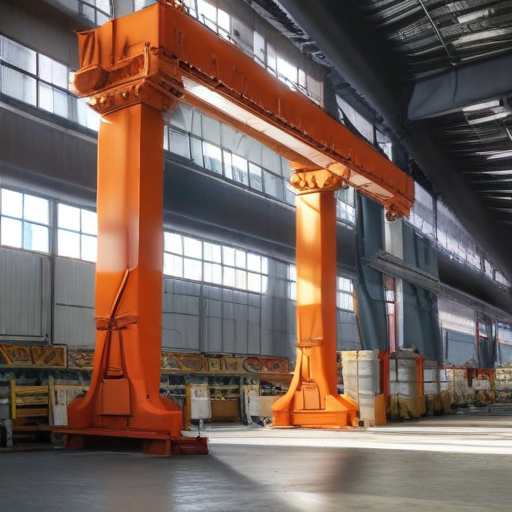
List Various Types of “warehouse gantry crane”
Warehouse gantry cranes are essential for handling heavy materials in storage and distribution centers. Different types cater to various needs:
1. Full Gantry Crane
– Structure: Two supporting legs moving on fixed rails.
– Usage: Ideal for outdoor storage, moving heavy items over a large area.
2. Semi-Gantry Crane
– Structure: One leg runs on a rail or runway fixed at ground level, while the other runs on an elevated rail.
– Usage: Suitable for indoor and outdoor operations where space is limited.
3. Portable Gantry Crane
– Structure: Smaller, mobile on wheels.
– Usage: Flexible for light to moderate lifting tasks, easy to transport within facilities.
4. Adjustable Gantry Crane
– Structure: Height and span can be adjusted.
– Usage: Versatile for varying lifting heights and widths, enhancing operational flexibility.
5. Single Girder Gantry Crane
– Structure: Single girder spanning between legs.
– Usage: Suited for moderate weight loads, economic option for workshops and storage areas.
6. Double Girder Gantry Crane
– Structure: Two girders providing increased strength.
– Usage: Used for heavy lifting tasks, large warehouses, and industrial applications.
7. Rail-Mounted Gantry (RMG) Crane
– Structure: Moves on fixed tracks laid on the ground.
– Usage: Ideal for container handling and heavy-load outdoor storage.
8. Rubber-Tired Gantry (RTG) Crane
– Structure: Mobile with rubber tires.
– Usage: Offers mobility for container handling in intermodal yards.
9. Cantilever Gantry Crane
– Structure: Extends beyond support columns on one or both sides.
– Usage: Increases loading area without additional rail length.
10. Workstation Gantry Crane
– Structure: Light-duty, overhead or floor-mounted.
– Usage: Enhances efficiency in specific work areas for light lifting.
Each type of warehouse gantry crane offers unique advantages tailored to specific operational requirements, enabling efficient material handling and optimization of storage space.
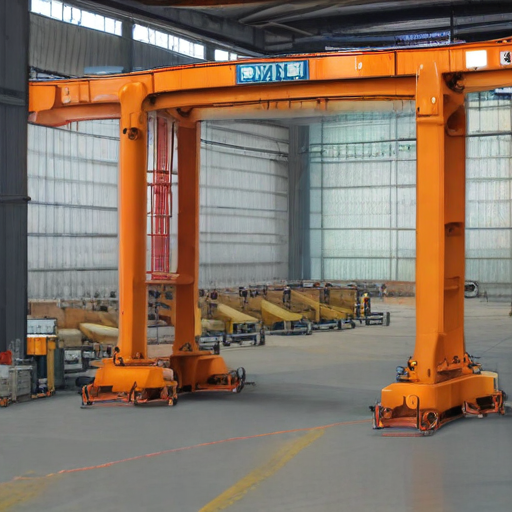
warehouse gantry crane Accessories Upgrades and Custom Manufacturing Options
Upgrading and customizing a warehouse gantry crane can significantly enhance efficiency, safety, and versatility. Here are some key accessories, upgrades, and custom manufacturing options to consider:
Accessories:
1. Lift Magnets: Ideal for handling ferrous materials quickly and safely.
2. Spreader Beams: Enhance load stability by distributing weight evenly.
3. Remote Controls: Offer enhanced operational safety and convenience.
4. Load Cells: Ensure precise weight measurements to prevent overloading.
5. Jib Cranes: Extend operational reach and flexibility within confined spaces.
6. Limit Switches: Improve safety by restricting operational range.
7. Custom Hooks & Slings: Tailor lifting solutions to specific material handling needs.
Upgrades:
1. Automated Systems: Incorporate automated solutions for improved productivity.
2. Variable Frequency Drives (VFD): Enhance control over speed and reduce mechanical stress.
3. Anti-Sway Technology: Minimize load sway for safer and more efficient handling.
4. Weatherproofing: Ensure longevity and reliability in harsh conditions through specialized coatings and seals.
5. Enhanced Ergonomics: Invest in operator cabins with climate control, adjustable seats, and improved visibility.
6. Energy-Efficient Motors: Reduce operational costs and environmental impact.
Custom Manufacturing:
1. Tailored Capacity: Design cranes to handle specific weight requirements, beyond the standard capacities.
2. Dimensional Adjustments: Custom designs to fit unique warehouse layouts or height restrictions.
3. Specialized Gantry Designs: Adapt configurations like double-girder or semi-gantry to meet specific operational demands.
4. Material Options: Choose high-strength alloys or corrosion-resistant materials for specialized environments.
5. Integration with Existing Systems: Seamlessly incorporate the crane into current material handling systems and workflows.
Conclusion:
Optimizing a gantry crane through these accessories, upgrades, and custom manufacturing options can significantly impact operational efficiency and safety. Whether for standard tasks or specialized applications, tailored solutions ensure the crane meets your unique warehouse needs.
List Quality Control and The Manufacturing Process of “warehouse gantry crane”
Quality Control and The Manufacturing Process of Warehouse Gantry Crane
Quality Control:
1. Material Inspection: Check all incoming raw materials (steel, cables) for specifications and compliance.
2. Dimensional Accuracy: Verify dimensions of fabricated components to ensure adherence to design tolerances.
3. Weld Quality: Conduct non-destructive testing (NDT) like ultrasonic or magnetic particle inspection to check weld integrity.
4. Load Testing: Perform load tests to ensure the crane can handle maximum rated load without failure.
5. Electrical Systems Check: Inspect wiring, control panels, and limit switches for proper function.
6. Alignment and Calibration: Ensure runway beams and gantry components are properly aligned and calibrate movement mechanisms.
7. Surface Treatment: Check for proper application of corrosion-resistant coating or paint.
8. Final Inspection: Conduct a comprehensive final inspection covering all mechanical, structural, and electrical aspects before dispatch.
Manufacturing Process:
1. Design and Planning: Engineering team designs the crane based on specific warehouse requirements and standards.
2. Material Procurement: High-quality steel and components are sourced according to the design specifications.
3. Cutting and Fabrication: Steel plates and sections are cut and fabricated into crane components (girders, legs, end trucks) using CNC machines and welding techniques.
4. Assembly: Major parts like the girder, trolleys, and end trucks are assembled, often modularly, in the factory.
5. Machining: Critical components such as wheels and axles are machined to precise dimensions for optimal performance.
6. Welding: Structural welding is done to join parts, followed by NDT to ensure weld quality.
7. Machinery Installation: Motors, wheel assemblies, and hoisting mechanisms are installed.
8. Electrical Installation: Wiring and electrical components are fixed and configured.
9. Painting and Surface Treatment: Assembled units are cleaned, primed, and painted to resist environmental wear.
10. Functional Testing: The fully assembled crane is tested for operational performance, including load testing.
11. Disassembly and Packaging: For ease of transport, the crane may be partially disassembled, packed, and shipped to the installation site.
12. On-site Installation: Final assembly and installation are performed at the warehouse location, followed by final testing and commissioning.
This streamlined process ensures that warehouse gantry cranes are manufactured to high standards of quality and reliability.
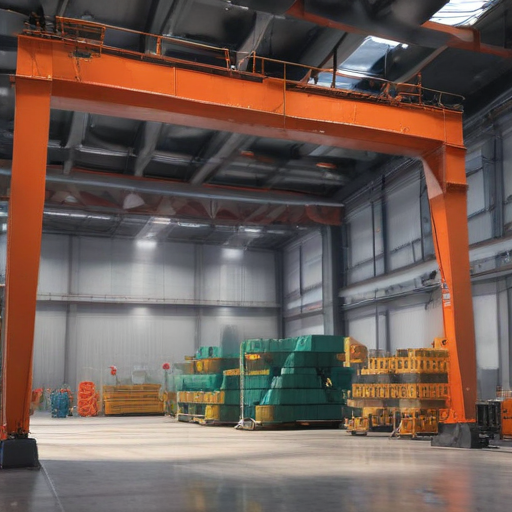
How to use “warehouse gantry crane”
A warehouse gantry crane is a useful piece of equipment for lifting and moving heavy loads within a warehouse. Here’s a step-by-step guide to using it safely and efficiently:
1. Inspection: Before use, inspect the crane for any signs of wear or damage. Ensure that all parts, including the hoist, cables, and control systems, are in good working condition.
2. Clear the Area: Ensure the path is clear of obstructions and people. This helps in avoiding accidents and ensures smooth operation.
3. Load Preparation: Securely attach the load to the crane’s hook using the appropriate slings or chains. Double-check that the load is balanced and properly fastened to avoid slips.
4. Operation: Use the control panel or remote to operate the crane. Lift the load slowly to ensure it is securely attached and balanced. Avoid sudden movements which could cause the load to swing.
5. Navigation: Move the crane along the designated track, maintaining a safe speed. Ensure you have a clear line of sight or have a spotter guide you if visibility is compromised.
6. Lowering the Load: Once you reach the desired location, lower the load carefully. Ensure the area below is clear of obstructions or personnel.
7. Unloading: Safely detach the load from the crane’s hook.
8. Post-Operation Check: After use, conduct a post-operation check to ensure the crane is in good condition for its next use. Report any issues to maintenance immediately.
Safety Tips:
– Always follow the manufacturer’s guidelines.
– Never exceed the crane’s maximum load capacity.
– Regularly conduct maintenance checks.
– Ensure all operators are properly trained and certified.
By following these steps, you can use a warehouse gantry crane effectively and safely.
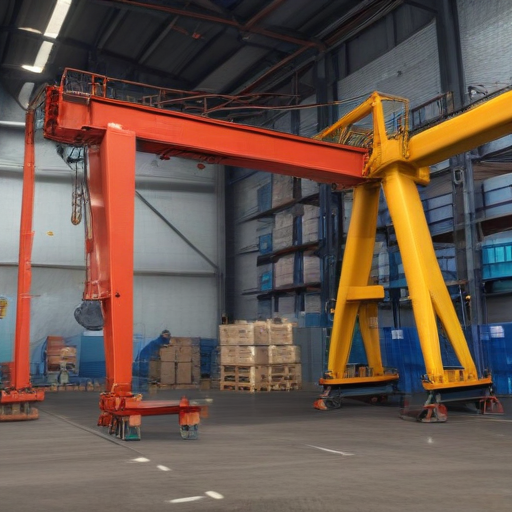
“warehouse gantry crane” Comparative Analysis
A warehouse gantry crane is a type of overhead crane with a single or double girder setup supported by freestanding legs that move on wheels or along a track. It is specifically designed for lifting and moving heavy items within a warehouse setting.
Comparison with Other Types of Cranes:
1. Overhead Bridge Crane:
– Structure: Unlike gantry cranes, overhead bridge cranes are typically fixed to the structure of the warehouse.
– Mobility: Gantry cranes offer greater mobility because they are not permanently fixed and can be relocated within the warehouse or to different facilities.
– Installation: Gantry cranes offer simpler installation as they do not require a runway structure built into the warehouse.
2. Jib Crane:
– Capacity: Gantry cranes generally have a higher load capacity compared to jib cranes.
– Range of Motion: Jib cranes offer a more limited range of motion, typically covering a circular area, while gantry cranes can cover rectangular areas.
– Flexibility: Gantry cranes can span larger distances and serve multiple areas of a warehouse, whereas jib cranes are fixed-point solutions.
3. Mobile Crane:
– Portability: Mobile cranes can be transported easily between different locations whereas gantry cranes are generally confined to their track system inside a warehouse.
– Versatility: Mobile cranes are versatile for different terrains and outdoor activities, but gantry cranes are more specialized for indoor usage thanks to their operational precision and track-bound stability.
Pros of Warehouse Gantry Cranes:
– Flexibility: Easily repositioned within the facility.
– Space Efficiency: Utilize vertical space effectively.
– Cost-Effective: Often less costly in terms of installation and frames compared to fixed overhead cranes.
Cons of Warehouse Gantry Cranes:
– Footprint: Legs can obstruct warehouse floor space.
– Capacity Limits: Generally, they have lower lifting capacities compared to some fixed overhead cranes.
In conclusion, warehouse gantry cranes offer valuable flexibility and cost efficiency for various material handling needs within the constraints of a warehouse environment, balancing effectively between stability, capacity, and mobility.
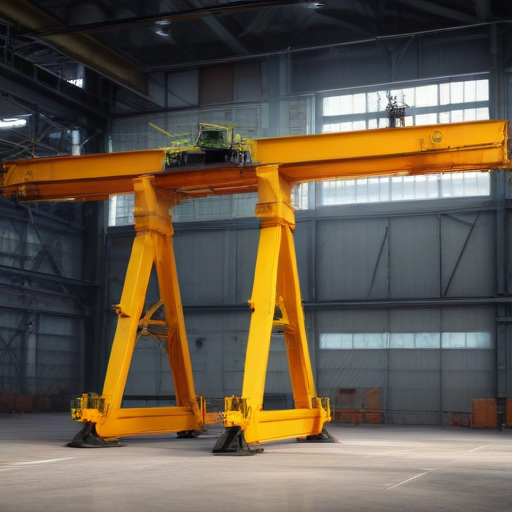
“warehouse gantry crane” Warranty and Support
Warranty and Support for Warehouse Gantry Crane
When you invest in a warehouse gantry crane, securing robust warranty and support terms ensures peace of mind and optimal performance. Typically, our warehouse gantry cranes come with a comprehensive warranty that covers a period of one to two years, depending on the specific model and manufacturer. The warranty often includes coverage for any defects in materials or workmanship, which means any faulty parts will be repaired or replaced at no additional cost.
In addition to the warranty, we provide extensive customer support to assist you throughout the crane’s lifecycle. Our support services include:
1. Installation and Setup Assistance: Our certified technicians offer on-site installation and setup to ensure your crane operates efficiently from day one.
2. Maintenance Support: Regular maintenance is crucial for your crane’s longevity. We offer scheduled maintenance services and provide detailed guidelines for routine checks.
3. Technical Support: Our experts are available via phone or email to resolve any operational issues or answer technical queries. Remote diagnostics and troubleshooting are often provided to minimize downtime.
4. Spare Parts Availability: We maintain a comprehensive inventory of spare parts to ensure quick replacement and minimal disruption to your operations.
5. Training Programs: Safety and proper usage are paramount. We offer training sessions for your staff to ensure they are well-versed in operating the gantry crane safely and efficiently.
6. Upgrade and Retrofit Options: As technology evolves, we provide upgrade and retrofit services to keep your equipment up-to-date and enhance its performance.
Customer satisfaction is our priority, and our dedicated support team works relentlessly to ensure that your warehouse gantry crane remains an indispensable asset to your operations. For detailed terms and conditions of the warranty and support packages, please consult the specific product documentation or reach out to our customer service team.
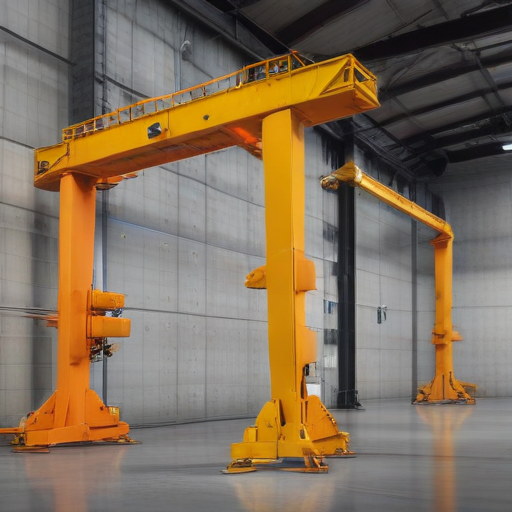
List “warehouse gantry crane” FAQ
Warehouse Gantry Crane FAQ
1. What is a warehouse gantry crane?
A warehouse gantry crane is a type of overhead crane with a single or double girder configuration supported by freestanding legs that move on wheels or a track system. It is designed for lifting and transporting heavy loads within a warehouse environment.
2. How does a gantry crane differ from a bridge crane?
While both cranes perform similar tasks, a gantry crane’s legs support the main girder and travel directly on the floor or on rails, making it suitable for spaces where overhead crane support structures are not feasible.
3. What are the main components of a warehouse gantry crane?
Key components include the main girder, support legs, hoist trolley, wheels, and sometimes tracks or rails. The control system, either manual or powered, is also essential.
4. What are the typical load capacities of warehouse gantry cranes?
Load capacities can vary widely, from a few tons to several hundred tons, depending on the design and application requirements.
5. What safety features are included in warehouse gantry cranes?
Common safety features include overload protection, emergency stop functions, limit switches, anti-collision systems, and compliant safety standards like OSHA and ASME guidelines.
6. Can warehouse gantry cranes be customized?
Yes, many manufacturers offer customization options to fit specific industrial needs, including variations in span, height, load capacity, and mobility.
7. How do you maintain a warehouse gantry crane?
Regular maintenance involves inspecting the structural components, lubrication of moving parts, checking electrical systems, and ensuring that safety features are operational. Regular professional inspections are also recommended.
8. What is the installation process like?
Installation typically involves site assessment, foundation preparation if needed, assembly of crane components, installation of electrical systems, and rigorous testing to ensure operational safety.
9. Are there training requirements for operating a gantry crane?
Yes, operators usually need specific training and certification to handle gantry cranes safely. Training covers operational techniques, safety protocols, and emergency handling procedures.
10. What are the cost factors for a warehouse gantry crane?
Costs depend on factors such as load capacity, customization, brand, installation requirements, and additional safety or automation features.
These FAQs provide you with a basic understanding of warehouse gantry cranes, their components, safety measures, and operational requirements.
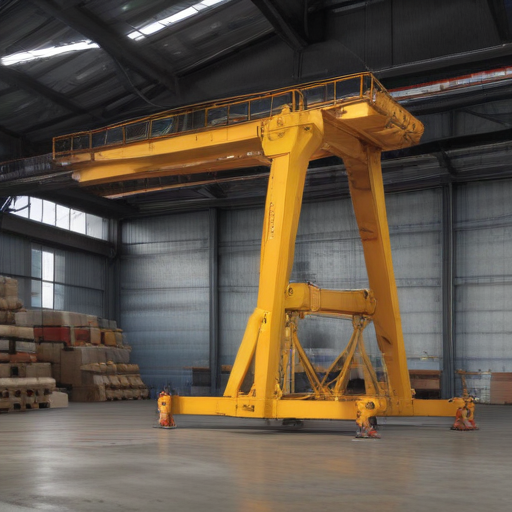
Top 10 FAQ with answer about warehouse gantry crane for Buyer Sourcing from China
Certainly! Here are the top 10 frequently asked questions (FAQs) about sourcing warehouse gantry cranes from China, along with concise answers:
1. What is a warehouse gantry crane?
A warehouse gantry crane is a type of overhead crane that features a bridge supported by legs that move on fixed rails or tracks, used for lifting and transporting heavy materials in warehouse environments.
2. What are the benefits of sourcing a gantry crane from China?
China offers competitive pricing, high-quality manufacturing, a wide variety of options, and advanced technology. Chinese manufacturers like Weihua, ZPMC, and Dalian Crane have a global reputation for reliability and innovation.
3. What certifications should I look for?
Look for ISO 9001 for quality management, CE Marking for European standards, and other local certifications like SGS, CCC, or OSHA compliance, depending on your region’s requirements.
4. How do I verify the quality of a Chinese manufacturer?
Conduct thorough due diligence: check certifications, ask for references, evaluate past projects, read customer reviews, and if possible, visit the factory to inspect their manufacturing processes.
5. What customization options are available?
Chinese manufacturers can customize cranes based on load capacity, span, lifting height, speed, control systems, and additional safety features to meet specific operational needs.
6. What is the typical delivery lead time?
Generally, lead times range from 30 to 60 days, depending on the complexity and customization requirements. Always confirm lead times directly with the manufacturer.
7. How are shipping and logistics handled?
Most manufacturers offer comprehensive shipping solutions, including FOB, CIF, and DDP terms. They coordinate with freight forwarders and help with customs documentation to ensure smooth delivery.
8. What after-sales support is available?
After-sales support includes installation guidance, training, maintenance services, parts supply, and technical support. Ensure the manufacturer offers a robust after-sales package.
9. How does payment work?
Common payment terms are 30% deposit upon order, with the remaining 70% paid before shipment. Some manufacturers also accept L/C (Letter of Credit) for added security.
10. What warranties are provided?
Typical warranties range from 12 to 24 months, covering defects in material and workmanship. Additional warranties or extended service plans can often be negotiated.
These FAQs cover essential aspects of sourcing warehouse gantry cranes from China, aiding buyers in making informed purchasing decisions.

